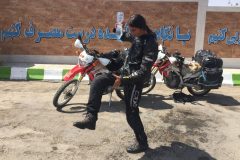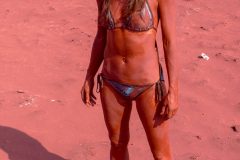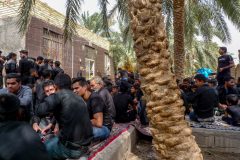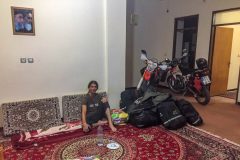On the way to Isfahan it is getting drier and hotter. For the first time, it feels like we have expected Iran to be. The route itself is quite unspectacular and we mainly pass barren desert landscape.
Isfahan is famous for its Persian architecture. We are a bit surprised how many tourists we suddenly meet here. So far we haven’t really seen any foreigners at all. In front of the Royal Palace on Naqsh-e-Dschahan Square you can hardly move anymore. Everything seems to be arranged for tourism and the local bazaar mainly consists of souvenirs. The mosque and the palace are unfortunately closed to the public at this time. We wait with many other people until it gets dark to see the play of light in the lake and the reflections of the surrounding buildings. Afterwards we return to our hotel – it’s just too crowded for us. Since we had “lost” 10 days for our India visa applications, we decide to skip the well-known desert city of Yazd. Yazd is not on our route to the Persian Gulf and we have already seen many desert cities in Uzbekistan. Some people may fall off their chairs in horror, but taking a detour of several hundred kilometers is simply not worth for us in this case.
So we continue to the next cultural city of Shiraz the next morning. We stop at a gas station after a while and notice two Swedish motorcycles. They are on a world trip and have roughly the same travel route. Since they also want to visit the island of Hormuz in the Persian Gulf, we agree to meet there in a few days.
Shortly before Shiraz is the ancient city of Persepolis. We leave the main street first to see the necropolis Naqsh-e Rustam. Once there, the view from a distance is quite nice, but it wasn’t worth it for us to pay for the entrance. We decide to skip Persepolis and go straight to Shiraz. On a long trip like that, you reach a point where you have seen so many ancient ruins and you aren’t sad anymore to miss some of them – or maybe we are just philistines.
In Shiraz we want to see the mosque Nasir ol Molk (pink mosque) in the evening, but we are advised to come in the morning, as the sun only shines into the premises at this time. So we go for a short city walk instead. Shiraz is full of tourists, too.
The next day we drive to the mosque early in the morning. Nasir ol Molk is quite small but luckily it is not full yet. The inner courtyard is very pretty and the well-known room with the stained glass windows, famous for its beautiful light, is very nice to look at. However half an hour later, there are already around 50 people in the room taking hundreds of photos. It quickly becomes too crowded for us. The pink mosque is beautiful, but not nearly as impressive as the photos make it appear.
After breakfast the next morning we ride to the Persian Gulf to the port city of Bandar Abbas. The climate there is abnormally humid. Any tropical rainforest we have seen before, was a joke compared to that. Interesting because there are hardly any trees and it looks like a dry desert. There isn’t really much to see in the city itself. However, the culture is different and the people already look much more African than in the rest of Iran.
Our actual destination is Hormuz Island. Hormuz is a small volcanic island in the Persian Gulf. There aren’t many people and tourists at this place. It is known for its multi-colored layers of sediment. That’s why it is also called Rainbow Island. A few times a day a small boat goes to the island. When we arrive at the ticket counter and I tell the lady at the counter, that we want to take our motorcycles to the island, she says that motorbikes are not allowed. However I saw a report in the internet of a tourist, that managed to go there with his own bike. So I explain it to her with Google Translate. After a short phone call, the nice lady says, that they are going to make an exception for us.
When we arrive at the pier, the ship has no ramp at all. So we have to clear our luggage and lift the motorcycles with four helpers over the ship’s rail to bring them on board. Fortunately after an exciting lifting action, the two motorcycles are unharmed and I can fix them with lashing straps. The drive to Hormuz is quite rough and some passengers can have a look at their breakfast for a second time. An hour later we are already on the small island.
It’s not quite as humid as on the mainland and it is afternoon already. The circular track around the island is only about 30 kilometers (~19mi). We drive almost completely around the island and pitch our tent right on the beach. The coastal area on Hormuz would actually be beautiful, unfortunately there is garbage everywhere. The garbage problem basically exists throughout Iran. The attitude towards garbage is similar to many other countries in Asia – things you don’t need anymore are simply thrown away into the enviroment. So many beautiful places are often heavily littered.
The next morning we meet our Swedish friends again and explore the island a little bit more intensive. The biggest part of the main road around the island is unpaved. The gravel changes colors within a few kilometers. The main colors are red, brown, white, purple and yellow. At the south end there is a beach with black glimmering sand. The rock above and below is bright red. Therefore the sea is also colored red at this beach. You inevitably feel an impulse to paint yourself in such a colourful enviroment. We mix red earth with a little water and color ourselves like Indians. All four of us want to be red though. The sea is quite rough at this beach and there are many stones and rocks in the water after a few meters. So its not really a pleasure to have a swim here. It also turns out, that the red color is difficult to wash off, so we explore the rest of the island with a slight red complexion.
We spend the night at the same place as the night before. As soon as it is dark you can see the neighbouring islands, Bandar Abbas and many cargo ships on the way to Dubai.
The next day we drive back to Bandar Abbas and look for a washing service for our motorcycles. During the crossing they were completely soaked in salt water and we want to prevent them from rusting all over the place. The two Swedes stay on Hormuz for a few more days. At the washing station we are immediately invited by the friendly owner for a cup of tea and when we ask for a cheap hotel, Saeed invites us to his house to stay for the night without further ado. He serves us with a beautiful dinner, a fresh shower and we have a fantastic time at his place. We are still red at this time.
After breakfast the next morning we make our way to Bam. In Bam we find a small inn and are taken to the Muharram ceremony the next day. During the first ten days of the mourning month of Muharram, the Shiites observe the Ashura rites in which they commemorate the death of Imam Al-Husain in the battle of Kerbala. It is the highest Shiite funeral festival. The city center is full of people. Free food and drinks are distributed everywhere. Men and women are separated. The men stand in front of a stage, where stories and rites are held. They hit their backs with chains on short handles. The women sit huddled further back in the shade of the buildings. It’s hot and the ceremony goes on for hours. To cool off, the crowd is occasionally sprayed with perfumed water. The security precautions are pretty strict and you have checks every few meters. The handful of tourists present are finally brought to the snipers on a roof. From there we can observe the ceremony and its size particularly well.
Afterwards private persons invite people for lunch. We can also participate. The private house is surrounded by a larger courtyard. The women sit in the house to eat and the men dine in the courtyard. I estimate the crowd consists of ~200 people. So you can get an idea of how full the house and the yard were at that time. All food for all of these people is donated exclusively by this family – impressive isn’t it?
In the afternoon we continue towards Zahedan. Wild camping is not recommended in this area anymore. The Afghan border is very close and, depending on the security situation, you will already be escorted by police in this area. When it gets dark we ask at a police check post whether we can pitch our tent there. The officers look a bit puzzled first, but offer us a small hut immediately. They even sweep the whole place and clear out the rubbish. When we have just spread our stuff, a police car comes with a senior officer. He says, that the place is not good and we should follow him to the next town. We are brought to a kind of overnight accommodation for diplomats, where we can sleep for free. However the next day, we get our first police escort.
We drive around Zahedan and stop at a larger police station, where we have to wait a long time. A young Iranian, who is doing his military service, starts talking excitedly to us. He is also the only one who knows English. We don’t know why we have to wait such a long time, because it doesn’t seem like they have a shortage of unengage police officers. After two hours one of the men says it will go on. He points to a lanky colleague and points to me and my motorcycle. I have to laugh first, since I think he’s kidding – he wasn’t. So I spend the next few kilometers with an armed police officer in the nonexistent space between me and my luggage. Miriam is cracking up, while driving behind us. Luckily after 20km we stop at another checkpost and are allowed to continue all the way to the border without any escort.
The landscape is absolutely dry and barren. Even dead camels are often lying next to the road, what shows how hostile this area seems to be. White watchtowers stand in the desert at greater intervals. In the distance you can see mountains on both sides. Otherwise there is nothing here.
In the afternoon we reach the border. It is not busy and the border closes at 4 p.m. The process goes smoothly and half an hour later we are already in the notorious Pakistan.
Iran is one of the countries, where you only hear bad news in our western media. However only a few people, that have travelled to this country, actually know, how this country really is. Iran should be an educational “must-travel-to-country” to prevent the one-sided western reporting. It is one of the friendliest and most hospitable countries we have ever visited. The reality is, that many Iranians don’t differ that much from us Europeans. They like hiking, camping, travelling, partying etc. and are surprisingly open minded. Unfortunately Iran also has its dark side. It doesn’t really affect you as a traveller, but you learn a lot by travelling there for a longer time. This “dark side” is not wanted by the majority of the population, but they don’t have a choice either. Therefore my second Iran post was called “The friendliest (most hospitable) prison in the world”. We hope that this will change one day!






























